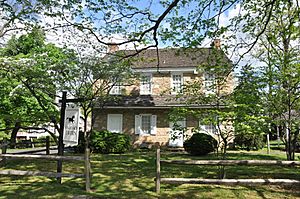Fallsington, Pennsylvania facts for kids
Quick facts for kids
Fallsington, Pennsylvania
|
|
|---|---|
|
Unincorporated community
|
|

Stage Coach Tavern
|
|
| Country | United States |
| State | Pennsylvania |
| County | Bucks |
| Township | Falls |
| Elevation | 92 ft (28 m) |
| Time zone | UTC-5 (Eastern (EST)) |
| • Summer (DST) | UTC-4 (EDT) |
| ZIP code |
19054
|
| Area code(s) | 215, 267 and 445 |
| GNIS feature ID | 1174608 |
Fallsington is a small, historic community in Falls Township, Bucks County, Pennsylvania, United States. It is an unincorporated community, meaning it does not have its own local government like a city or town.
Contents
Where is Fallsington?
Fallsington is located at 40.187 degrees North latitude and 74.819 degrees West longitude. These numbers help pinpoint its exact spot on a map. The community is in the Eastern Standard Time Zone. It sits about 92 feet (28 meters) above sea level.
A Look Back: Fallsington's History
Fallsington began as a "crossroads community" in the 1700s. This means it was an important stop where main roads met. One of these roads was the Kings Highway, which is now called U.S. Route 13.
Early Days and Important Buildings
The Bucks County Courthouse was once in Fallsington, starting in 1663. It later moved to Bristol in 1705. The first meetings of the Religious Society of Friends, also known as Quakers, were held in the home of William Biles on Biles Island.
Around 1690, the Quakers built their first brick meetinghouse in Fallsington. This building was on 6 acres (0.024 square kilometers) of land given by Samuel Burgess. Also in 1690, Thomas Janney donated 72 acres (0.29 square kilometers) of land for the Quaker burial grounds. William Penn, who founded Pennsylvania, also gave 120 acres (0.49 square kilometers) of land for a common area in Fallsington.
Growth and Community Life
Fallsington grew steadily over many years. You can still see homes from the late 1600s all the way to the mid-1800s. These buildings show different styles of American architecture.
Fallsington was a busy center for business. In the 1860s, the community had many different workers. There were blacksmiths, a butcher, carpenters, and even a carriage builder. You could also find farmers, doctors, and people who fixed wheels.
The community continued to grow with new homes, an inn, public buildings, and shops. For a long time, Fallsington was the biggest settlement in Falls Township. It was an important place for trade and services until newer towns like Fairless Hills and Levittown were built.
Historic Recognition
Because of its rich history and well-preserved buildings, the Fallsington Historic District was added to the National Register of Historic Places in 1972. This means it's recognized as a special place worth protecting.
Fun Facts About Fallsington
- The "falls" of the Delaware River are not like a huge waterfall. Instead, they are rapids that mark the highest point on the river where boats can travel. The names Fallsington and Falls Township come from these rapids.



